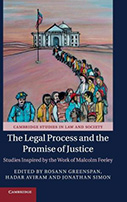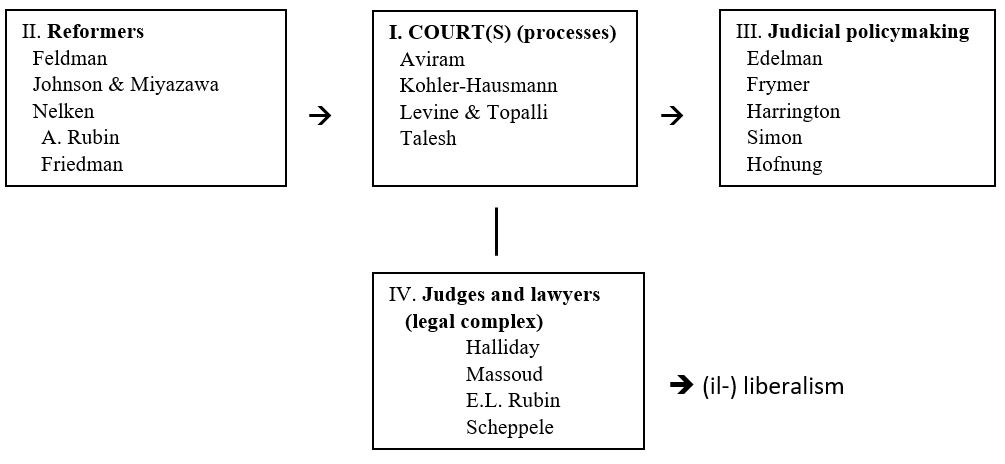The Legal Process And The Promise Of Justice: Studies Inspired By The Work Of Malcolm Feeley

Editors: Rosann Greenspan, Hadar Aviram, and Jonathan Simon
Publisher: Cambridge, UK; New York: Cambridge University Press, 2019. 400p.
Reviewer: Joachim J. Savelsberg | August 2021
The challenge of reviewing an edited book diminishes greatly when the book has a clear core, and when the total is more than the sum of its parts. That is the case indeed with The Legal Process and the Promise of Justice. At the core of the book are the ideas Malcolm Feeley has contributed to socio-legal scholarship in the course of his long and distinguished career. Writing a review on this kind of book is in fact a delight when the scholar so honored is as much a Mensch and a great intellectual as Malcolm Feeley. The following speaks to the structure of the book and the underlying social organization of scholarship, and to the ideas and insights with which Feeley and the book’s contributors engage. It ends with brief suggestions for further enrichment.
Social Organization of Scholarship and the Structure of the Book
Four sections capture the core ideas around which the editors organized the book: Part I: The Process is the Punishment; Part II: Court Reform on Trial; Part III: Judicial Policymaking and the Modern State; and Part IV: Political Liberalism and the Legal Complex. The authors represent multiple fields and disciplines: political science, sociology, law and society studies, law, criminology, history and international affairs. This variety and the division of the book into four parts actually underplays its unity and coherence (see Figure 1). In the beginning (of Feeley’s career) was the court, and all that followed came in relation to the court.
Figure 1: Structure of the Book and Contributors

The unity of the book relies on the social organization on which it is based. To borrow a term from the sociology of science, the book displays an invisible college whose members adhere to a specific intellectual style. Tables or figures are virtually absent. Theoretical thought, intimate familiarity with the ethnographic subject, historical depth and case studies dominate.
Randall Collins’ Sociology of Philosophies helps us make further sense of this organization. Collins sees the thinking individual at the center of intellectual work. In our case, we imagine Malcolm Feeley writing at his desk. Given his immense productivity, he must have spent much time in that position. Yet the thinker/writer is never alone. He engages in inner conversations with members of his intellectual network. Consider vertical network ties: the editors’ introduction reminds us of Feeley’s graduate training in political science at Minnesota, his exposure to Sam Krislof, Harold Chase and Ed Fogelman in his home department, E. Adamson Hoebel in anthropology, Arnold Rose in sociology, Robert Gerstein in legal history, and Jeffery Murphey in the philosophy of law. Vertical network ties then link Feeley to the next generation: nine contributors to the current volume had experience with him as a teacher or advisor. Horizontal network ties supplement vertical ones: several senior colleagues contributed to the current volume, many from law and society programs at other prestigious institutions.
Networks, and this is another step in Collins’ model of intellectual life, are enabled by institutions. In this case, the core is the University of California at Berkeley and its Institute for Law and Social Policy. This institutional circle overlaps with that of the Law & Society Association. Like Feeley, several contributors to the book are former LSA Presidents and/or editors of its journal, the Law & Society Review. There are further overlaps with other law and society programs and the American Bar Foundation. Institutions, networks they enable, and ideas they generate are contingent on the larger socio-political environment in which they operate. Despite international contributions from Israel, Japan and the U.K., this is primarily the world of the United States, with its liberal democracy and with the turbulences, movements, political shifts and policy changes it experienced in the course of Malcolm Feeley’s career.
Ideas and Arguments
In his 1979 book, The Process is the Punishment: Handling Cases in the Lower Criminal Courts, Feeley alerted us to the indignities of those courts, in which most criminal cases were processed at the time, the pain of arrest and jail, and the chaotic conditions of the courts themselves. Feeley had drawn inspiration from Amitai Etzioni, applying ideas from his sociology of organizations to courts. Following Etzioni, he recognizes organizations as settings with uncertain goals and conflicting actors. In light of the growing intensity of punishment and the mass imprisonment that began to build up in the 1970s, scholarly attention shifted away from these lower criminal courts. Yet the editors rightly emphasize that the current era of criminal justice reform justifies renewed scholarly attention to “the lower portions of the court system … as important sites of policy entrepreneurship … and critical social science inquiry” (2). Contributors to this volume build on Feeley’s insights. Kay Levine and Volkan Topalli show, with particular attention to the children and to the transgenerational transmission of stigma and traumatic experiences, that the process is not just punishment for the accused. Shaulin Talesh finds Feeley’s insights confirmed in the realm of civil litigation and alternative dispute resolution. Two additional chapters link Feeley’s work to other (or underlying) theoretical traditions. Hadar Aviram enriches Feeley’s organizational perspective with insights from the behavioral sciences. Issa Kohler-Hausmann links the roots of Feeley’s pragmatic approach to John Dewey’s concept of normative ordering, an ordering which unfolds—following Feeley’s insights—always within organizational contexts.
Only four years after The Process book, Feeley published another milestone of socio-legal scholarship: Court Reform on Trial: Why Simple Solutions Fail. Feeley had in mind initiatives such as bail reform, pretrial diversion, speedy trials and determinate sentencing. Again, his organizational perspective leads the way. Feeley shows how reformers fail because they encounter a system with fragmented decision-making, reluctant politicians, and voiceless constituencies. Eric Feldman applies these insights to attempts at regulating e-cigarettes in three countries. David Johnson and Setsuo Miyazawa, writing about Japan, and David Nelken, with an emphasis on Italy, show the potential and limits of generalizing American experiences with court reform. Ashley Rubin applies Feeley’s organizational insights to prisons, where the institutionalization of punishment in formal organizations results in clashes between penal principles and organizational needs, frustrating the efforts of penal reformers. Finally, Lawrence Friedman shows how courts in Victorian England were conflicted between penal principles, patriarchal ideologies and social reform ideas when they practiced leniency toward women charged with neonaticide, the killing of their newborns. Today again, court reform has become a prominent theme as insights into the absurdity of mass imprisonment grow across the political spectrum. Feeley’s classic work and that of his successors and colleagues warn us against unrealistic hopes and thereby increase chances of success.
Feeley’s first major publication in which optimism trumps skepticism is his Judicial Policy making and the Modern State, co-authored by Edward Rubin and published in 1998. Here the authors find encouragement in the success that myriad federal court interventions of the 1960s to 1990s had on the practices of prisons and jails, especially the plantation style variety. Contributors to Part III of the book, however, challenge such optimism with the kind of skepticism that Feeley’s earlier work had fostered. Lauren Edelman finds courts to be subservient to organizational practice in the civil rights and employment arenas. Judges believe in the organizations’ compliance structures, despite their often purely symbolic gesturing. Paul Frymer finds similar reluctance to intervene in the realm of labor law. Christine Harrington goes further. She sees a judiciary at work that in fact undermines legislative efforts to protect women against violence, most noteworthy the Violence against Women Act of 1994. She sees a federal judiciary at work that, having developed substantial bureaucratic power, contributes to shaping the administrative state, often in a conservative direction. Jonathan Simon too expresses pessimism. Exactly in the “prisoners’ rights revolution,” he sees one root of the massive expansion of prisons and the establishment of managerial styles to which courts eventually deferred. He nevertheless leaves open a window for hope that courts may today become a vehicle toward the dismantling of mass incarceration. Menachem Hofnung evokes yet more hope with his analysis of hundreds of petitions by Arabs to Israel’s High Court of Justice. He shows that the Court, while reluctant to set precedent, effects social change by encouraging out of court settlements.
Finally, Part IV of the book is dedicated to the “legal complex.” It grows out of Feeley’s collaboration with Terence Halliday and Lucien Karpik and addresses the courts, in coalition with lawyers, as potential contributors to the establishment of liberal political regimes. Halliday, in his chapter expands the notion, directing our attention to an “international legal complex.” Mark Massoud strengthens the argument by developing a theory of justice that enhances the recognition of idealism in the legal profession, against a sole focus on the profession’s pursuit of materialist interests and the monopolization of markets. Here too, however, warnings abound. Edward Rubin identifies judicial independence as a condition of the legal complex’s contribution to political liberalism, and Kim Scheppele shows for Russia and Hungary how lawyers can in fact undermine political liberalism. Legal expertize may exactly enable the finding of loopholes that open the path toward illiberalism.
Limits of Communities and Potentials of Boundary Crossings
Invisible colleges have boundaries and networks have closure. Yet boundaries may be porous and network closure is relative. Porousness applies to the book under review and to the circle of contributors. Throughout the pages, readers find references to various traditions such as neo-institutionalism or legal consciousness theory. In addition, intellectual life within networks and invisible colleges is not free from conflict. In fact, conflicts and mutual challenges stimulate intellectual work for which the above summary gives multiple examples.
Nevertheless, additional boundary spanning beyond the invisible college may provide further inspiration, new perspectives, and at times confirmations, at other challenges. I find a tendency in the volume, for example, to focus on Max Weber as the prophet of the iron cage. Yet we know that his models of bureaucratic organization and formal-rational law were but ideal types, measuring rods against which to examine the actual nature of organizations and law in given historical contexts and spaces. Weber, the historical comparative analyst, saw clearly the challenges to modern bureaucracies and to formal rational law. He directed our attention toward legal clients who seek reasonable solutions to disputes, social justice advocates who object to the cold rationality of law and lawyers, who—out of status interests—resent being reduced to an automaton into which users drop the facts and the fees for them to spew out decisions and opinions. The point is in fact supportive of Feeley’s skepticism about the smooth functioning of courts and the challenges to court reform he identified. This reading of Weber fed into a wealth of quantitative empirical studies, like those by Jeffrey Ulmer and his colleagues that document the weight of organizational rationales in sentencing. Generally, taking this side of Weberian scholarship seriously could further enrich scholarship, directing our attention toward larger structural contexts, economic interests and social movements alike, beyond those highlighted by the invisible college built around Feeley’s work. The same applies to neo-Durkheimian perspectives, best represented in the work of Philip Smith and his colleagues. Here we learn that court and penal reform fail because they are always subject to meaning making by various audiences, often culturally polluted and in need of replacement. This author’s work has tried to show that such turnovers are especially frequent and rapid in the context of institutions of knowledge production and political and legal decision making in the United States.
In conclusion, The Legal Process and the Promise of Justice: Studies inspired by the Work of Malcolm Feeley is a book I recommend highly. It is skillfully put together by its three editors in honor of a colleague who inspired many, and who is more than deserving of the honor.
Joachim J. Savelsberg, University of Minnesota


